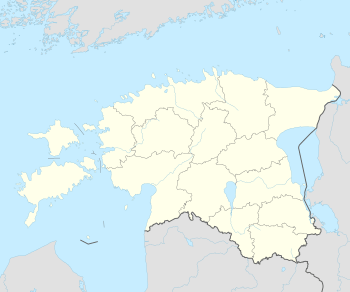Kalvi
| Kalvi | |
|---|---|
| Village | |
|
Main building of Kalvi Manor | |
 Kalvi Location in Estonia | |
| Coordinates: 59°28′49″N 26°47′17″E / 59.48028°N 26.78806°ECoordinates: 59°28′49″N 26°47′17″E / 59.48028°N 26.78806°E | |
| Country | Estonia |
| County | Ida-Viru County |
| Municipality | Aseri Parish |
| First mentioned | 1485 |
| Population (01.01.2012[1]) | |
| • Total | 51 |
Kalvi is a village in Aseri Parish, Ida-Viru County, in northeastern Estonia. It's located about 4 km (2 mi) north of the Tallinn–Narva road (part of E20), 5 km (3 mi) northwest of Aseri and 7 km (4 mi) northeast of Viru-Nigula, on the coast of the Gulf of Finland. Kalvi has a population of 51 (as of 1 January 2012).[1]
Kalvi is best known for its Medieval manor. It was first mentioned in 1485. The owners von Lodes had built there one of the grandiosest vassal fortresses in Estonia. Ca. 30 m wide trapezoid-shaped castellum type fortress was probably built in the beginning of the 15th century. It is also possible that the manor had existed already in 13th–14th centuries.
A new Early-Classical main building was erected on the eastern wing of the fortress by the von Essens. In 1910 it burned down and was replaced by a new luxurious eclectic main building nearby in 1913. The manor was owned by the von Stackelbergs until 1940. Nowadays a hotel and a restaurant operate in the building.[2][3]
Russian military commander Ivan Essen (1759–1813) was born in Kalvi Manor. Soviet Estonian political leader Johannes Käbin (1905–1999) was born in Kalvi before emigrating to Russia.
Gallery
 The ruins of the Kalvi fortress.
The ruins of the Kalvi fortress. The ruins of the old main building of Kalvi Manor.
The ruins of the old main building of Kalvi Manor. The new main building of Kalvi Manor from 1913.
The new main building of Kalvi Manor from 1913._ja_teenijatemaja_(regnr_13836)._2010.jpg) The granary and the servant house.
The granary and the servant house.
References
- 1 2 "Asukoht ja rahvastik" (in Estonian). Aseri vald.
- ↑ "Kalvi mõis" (in Estonian). Estonian Manors Portal. Retrieved 14 November 2012.
- ↑ "Kalvi küla" (in Estonian). eestigiid.ee. Retrieved 14 November 2012.
External links
- Kalvi Manor at Estonian Manors Portal

